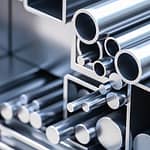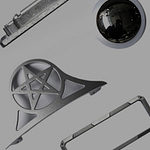7075 Aluminium vs. 6061 Aluminium: Which Alloy is Right for Your Application?
Aluminium is a versatile material available in various alloys tailored to specific applications. Among these, 7075 and 6061 aluminium alloys stand out for their unique properties and widespread use in aerospace, automotive, and marine industries. Choosing the suitable alloy requires careful consideration of strength, corrosion resistance, and machinability attributes. This article compares these two popular alloys to help you make an informed decision.
Chemical Composition
The primary difference between 7075 and 6061 lies in their chemical composition. These differences influence their properties, such as strength, corrosion resistance, and machinability.
| Element | 7075 Aluminium | 6061 Aluminium |
|---|---|---|
| Aluminium | Remainder (~90%) | Remainder (~97%) |
| Zinc | 5.6% | – |
| Magnesium | 2.5% | 0.1% |
| Chromium | 0.23% | 0.2% |
| Copper | 1.6% | 0.28% |
| Silicon | – | 0.6% |
- 7075 Aluminium: Part of the 7XXX series, it uses zinc and copper as its primary alloying elements, resulting in high strength.
- 6061 Aluminium: This alloy belongs to the 6XXX series and primarily contains magnesium and silicon, which enhance its corrosion resistance and weldability.
Key Differences in Properties
Both alloys exhibit distinct properties that suit different applications. Below is a comparison based on critical characteristics:
Strength
- 7075 Aluminium (T6 Condition): This alloy is known for its exceptional strength, with a tensile strength of up to 503 MPa, making it ideal for high-stress applications like aerospace and military.
- 6061 Aluminium (T6 Condition): It offers moderate strength, with a tensile strength of 276 MPa, sufficient for structural and everyday applications.
Machinability
- 6061 Aluminium: Easier to machine, making it the preferred choice for applications requiring extensive machining processes.
- 7075 Aluminium: Harder to machine due to its higher hardness, it still offers fair machinability.
Formability and Welding
- 6061 Aluminium: Excellent formability and weldability, thanks to its balanced composition of magnesium and silicon.
- 7075 Aluminium: Poor formability and weldability due to its hardness and zinc content, though it can be welded in an annealed condition.
Corrosion Resistance
- 6061 Aluminium: Superior corrosion resistance due to its high aluminium content and lower copper concentration.
- 7075 Aluminium: Offers good corrosion resistance, but the presence of copper makes it more prone to corrosion in harsh environments.
Anodizing
Both alloys respond well to anodizing but with some caveats:
- 6061 Aluminium: Produces a transparent, durable oxide layer, enhancing corrosion resistance and aesthetics.
- 7075 Aluminium: Also anodizes well, but excessive zinc can sometimes result in a brownish oxide layer.
Thermal Conductivity
- 6061 Aluminium: Higher thermal conductivity (167 W/m-K), making it better suited for heat dissipation in electronics and machinery.
- 7075 Aluminium: Lower thermal conductivity (130 W/m-K) but compensates with superior strength.
Density and Weight
Density influences weight-sensitive applications, such as in aerospace and automotive:
| Property | 7075 Aluminium | 6061 Aluminium |
|---|---|---|
| Density (g/cm³) | 2.81 | 2.70 |
6061 is slightly lighter, but the difference is minimal.
Applications
The differences in strength, machinability, and corrosion resistance make each alloy suitable for specific industries and applications:
7075 Aluminium
Known as “aircraft-grade aluminium,” 7075 excels in high-stress and wear applications:
- Aerospace: Aircraft and spacecraft components
- Military: Missiles and defence equipment
- Automotive: Performance parts like chassis and suspension components
- Sports: High-performance bicycles and climbing equipment
6061 Aluminium
This alloy is highly versatile and used across a broad range of industries:
- Marine: Yachts, sailboats, and other shipbuilding hardware
- Automotive: Trucks, hydraulic pistons, and bus bodies
- Construction: Structural applications, mouldings, and awnings
- Consumer Goods: Furniture, electronics, and appliance fittings
Comparison Table
| Property | 7075 Aluminium | 6061 Aluminium |
|---|---|---|
| Tensile Strength | 503 MPa | 276 MPa |
| Yield Strength | 434 MPa | 241 MPa |
| Hardness (Brinell) | 150 | 95 |
| Machinability | Fair | Good |
| Corrosion Resistance | Moderate | Excellent |
| Thermal Conductivity | 130 W/m-K | 167 W/m-K |
Cost Consideration
7075 aluminium is more expensive than 6061 due to its higher strength and advanced processing requirements. If your application prioritizes cost-efficiency and versatility, 6061 might be the better choice.
Conclusion: Choosing the Right Alloy
When deciding between 7075 and 6061 aluminium, consider the specific demands of your application:
- Choose 7075 for high-strength, high-stress applications where machinability and formability are secondary.
- Opt for 6061 for its excellent machinability, corrosion resistance, and versatility across various industries.
Both alloys offer unique advantages, and understanding these differences ensures you select the best material for your needs.














No comment